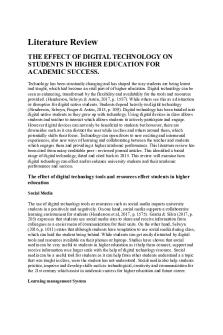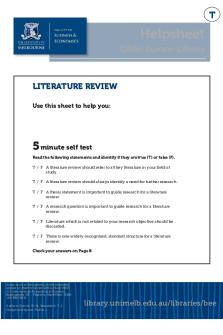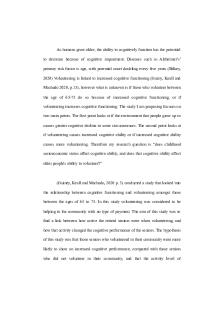Literature Review PDF

| Title | Literature Review |
|---|---|
| Author | Matthew Bromell |
| Course | Applied Research Methods and Statistics in Sport |
| Institution | University of Southern Mississippi |
| Pages | 10 |
| File Size | 101.3 KB |
| File Type | |
| Total Downloads | 102 |
| Total Views | 160 |
Summary
Literature Review for research assignment ...
Description
Literature Review eSports Study- SM682 Matthew Bromell
Since eSports is a relatively new field, there has not been a significant amount of study undertaken reviewing health risks for potential college athletes dedicating copious time to obtaining and maintaining proficiency at their chosen eSport. Only 40 eSports programs existed in North America at the beginning of 2017 according to Winter & Kauweloa, but it is a rapidly growing industry; today, there is a total of 9 million dollars of scholarship money available to potential eSports athletes in a competitive collegiate system that now has over 70 participating institutions. (Winter & Kauweloa, 2019) It has been identified as the ‘fastest growing sector of today’s sports industry.’ (Nielson & Karhulahti 2017 p. 1) This being said, as the industry continues to grow, more studies are being undertaken concerning all aspects of the sport, from health implications to economic impact. For instance, Zwibel, Shmidt et al contributed an article in 2018 to attempt to understand how a health management model could be introduced to monitor eSports athletes. They found that ‘the time spent sitting in front of a computer for a collegiate eSports player ranges from 5.5 to 10 hours daily’ and that eye fatigue was the most common ailment, along with hand, back and neck pain associated with using the controller and remaining in a fixed position for so long. ( Zwibel, Shmidt et al 2018 p.1). Also of concern is the finding that 40% of collegiate eSports athletes who were surveyed reported they did not participate in any physical activity. (Zwibel, Shmidt et al 2018 p. 1) This article concluded that eSports athletes should be treated similarly to traditional athletes medically, as they are also prone to overuse injuries and fatigue. This is highly suggestive of the necessity of further research being undertaken so the health
implications can first be understood, and then dealt with, if the field of eSports is to continue to expand and become more mainstream.
The American Psychological Association has suggested ‘Internet gaming disorder’ to be a legitimate ‘non substance addictive disorder’, which opens doors for further analysis of the concept through the lens of collegiate eSports. (Nielson & Karhulahti 2018 p. 1) The World Health Organisation has also identified conditions associated with gaming addiction and labelled them ‘hazardous gaming’ and ‘gaming disorder’, the latter of which is identifiable by an impaired control over gaming, ‘increased priority’ given to it over other aspects of life, and continuing to prioritise gaming ‘despite negative consequences.’ (WHO) According to the APA, Internet gaming disorder can be diagnosed by determining the presence of at least five of the following indicators: -
Preoccupation with video games,
-
Withdrawal symptoms from video games tole
-
Tolerance- ‘the need to spend increasing amounts of time on video games’ (Neilson & Karhulahti, 2017 p. 2)
-
Unsuccessful attempt to control the participation in video games
-
Loss of interests in previous hobbies and entertainment
-
Continued excessive use of internet games despite knowledge of psychosocial problems
-
Deceived family members, therapists or other regarding the amount of internet gaming
-
Use of internet gaming to relieve negative mood
-
Has jeopardized a job, significant relationship or educational or career opportunity because of participation in Internet games
Given that these factors have been determined to indicate a disorder, there is a significant overlap between factors an eSports competitor would exhibit purely by virtue of them being an eSports athlete and the indicators. This blurs the lines defining what is a disorder and what is competitive dedication; for instance, preoccupation with video games is synonymous with competitive play, as is ‘tolerance’ or the need to spend increasing amounts of time playing. eSports athletes are expected to practice long hours, meaning defining this as symptomatic of a disorder is problematic. With regards to jeopardizing a job: eSports, with its growing prize money, can now be considered a career pursuit itself, rendering the criterion invalid. Evidently there needs to be a re-evaluation of what constitutes Internet Gaming Disorder within the context of professional and collegiate eSports as the current method would amount to confusion and inconsistency.
Kauweloa & Winter addressed further incomprehension of the eSports field in their article, Taking College eSports Seriously, which aimed to ‘examine how college eSports athletes conceptualize their own competitive gameplay as situated between work and play’. (Kauewloa & Winter, 2019 p. 2448) Whether or not dedication to video games during college is conducive to personal and educational success is something that is currently unclear, and the various video game modes can demand different amounts and types of work and practice from players. Since MMORPG (massively multiplayer online role playing games) can demand hours of repetitive ‘grinding’ from players to produce virtual goods that can be used to upgrade players’ in-game abilities and equipment, significant amounts of time are spent purely
developing the online avatar. This affects the work/play dynamic in that the game demands persistence and dedication from players in repetitive, often tedious scenarios, which is ironic in that it exists in games that are typically seen as ‘forms of escapism’. (Kauweloa & Winter, 2019 p.2449) When it comes to diagnosing health issues from eSports, particularly mental health, there needs to be a better understanding of the attitudes players have towards gaming, seeing as it is often difficult to distinguish between leisure time spent on the game and hard labour. The literature has showed the problem that organisations such as the NCAA may encounter; currently the NCAA does not govern college eSports, and are ‘unsure about the space as a regulated competitive activity.’ (Kauweloa & Winter, 2019 p.2450) Understanding this problem could be the key to comprehending issues associated with gaming addiction disorder as identified by the APA; there is assuredly a link between addiction and the competitor’s conception of what he or she is doing as an expression of willing leisure or work, where work is defined as ‘emotional, intellectual, or physical effort expended, often against one’s will, in the aim of accomplishing a task or goal.’ (Kauweloa & Winter, 2019, p2450) Yet these notions can be further conflated, as ‘serious leisure’ can bring similar feelings of meaning and fulfilment as work, and some types of work are capable of enriching people in a way not dissimilar to leisure activities. (Kauweloa & Winter, 2019) Yet despite the potential video gaming has to be enriching, the self-consciousness of this reality can cause embarrassment in eSports athletes because of the position professional gaming has in society; it is seen as ‘geeky’ and ultimately an illegitimate method of competition and money-making, at least outside of the gaming sphere. This can lead to feelings of shame and isolation in gamers, with one respondent illustrating how he ‘cannot be public about it, without seeming geeky, obsessed or whatever.’ (Kauweloa
& Winter, 2019, p. 2454) This further distinguishes eSports from regular athletic sports, as dedication to physically demanding activities such as football is publically seen as healthy and worthy of praise. Physical athletes are often proud to boast of their dedication on the practice fields and in the weight room, happily disclosing the amount of time spent pursuing their goals, but gamers often ‘craft their gaming image in terms of not being too serious’ even though they spend 60 hours a week in practice. (Kauweloa & Winter, 2019 p2454) This further complicates attitudes towards eSports from players, as there is a certain societally imposed guilt on them for partaking so heavily in the competition. This has the potential to impact the mental health of players. Additionally, since the age of professional eSports players is much generally much younger than traditional pro sports (most are aged between 15 and 20) they are exposed to the pressures of high performance, fandom, and big crowds at alarming immaturity. Athletes are not prepared for such a transition from bedroom gaming to immense arenas and monolithic global streaming audiences.
Holden, Kaburakis & Holden have proffered that there are serious health implications from eSports participation associated with age. They have described professional eSports as ‘legitimised excessive consumption of an activity once thought to be best consumed in moderation.’ (Holden & co, 2018 p.830) First and foremost they describe the physical and mental exhaustion associated with spending considerable amounts of time competitively gaming; some children play for 12-14 hours a day and only manage to sleep 4 hours at night, exposing them to heavy fatigue. (Holden & co, 2018 p.830) This obsession with eSports extends beyond the actual competing; some streaming websites, such as Twitch, are known to on occasion stream gaming
tournaments for up to 24 hours just to satisfy the demand for the site’s content. Holden & co point out that this ‘marathon’ is heavily supported by over the counter stimulants, as participants and streamers struggle with the insatiable demands of the industry. (Holden & co, 2018 p.830) Dextroamphetamine is commonly used, and Adderall is utterly widespread. This is a serious concern when considering the age of the players competing and using these stimulants just to keep up. There is now a grey market operating to provide eSports participants with the drugs, some of which are caffeine or B-12, and some are herbal alternatives. Since eSports competitors do not physically exert themselves, and merely require enhanced focus and attention, this inactivity can worsen the side effects of the pharmaceuticals, which are often taken by young competitors in the first place, whose bodies are not mature enough to properly process the stimulant. It is clear that participants engage in this behaviour out of addiction; video games have been shown to stimulate the brain and cause the release of dopamine in a magnitude comparable with sex, gaming and illicit addictive substances by ‘flooding the brain’s pleasure centre with multiple stimuli.’ (Holden & co, 2018 p.830) MRI scans completed recently attempted to understand gaming addiction, and came to the conclusion that it can affect the brain of growing children in a manner ‘similar to cocaine addiction.’ (Holden & co, 2018 p.830) As well as the APA’s Internet gaming disorder, gaming abuse has been likened to other disorders, such as attention deficit hyperactivity disorder, anxiety, addiction, depression, psychosis and increased aggression. An Australian study found that attitudes towards gaming were consistently positive and mostly ignorant of the aforementioned issues; 89% of those gamers interviewed believed that video gaming improves thinking skills and health, -
79% believed gaming improves coordination and dexterity
-
76% believed video games increase mental stimulation (positive ageing)
-
and 61% believe video games could fight dementia
(Brand, Todhunter 2015 p5) This helps illustrate the overall attitude towards gaming expressed by participants- largely positive and ignorant of potential health issues should it begin to be taken more seriously. Most young people that transition into competitive eSports come from a recreational background and are unawares of the dangers associated with intense gameplay over long timeframes.
eSports are growing rapidly; in 2022 they will feature at the Asian Games as a medal event, and China will soon recognize gaming as a legitimate profession. (Myers, M 2017 p.1, Gera, E 2019) This will be a testing ground for their potential inclusion in the Olympics, which would be a statement that eSports is here to stay and is a legitimate contender for huge global audiences. The literature has illustrated copious potential problems associated with college and professional eSports, particularly health risks such as addiction, Internet Gaming Disorder, hand, wrist and eye problems, and issues arising from the sedentary lifestyle gamers occupy. Competitors are exposed to inactivity, but also take stimulants to cope with demanding schedules, which furthers physical health implications. Significant study needs to be undertaken on how to manage the health of eSports athletes, and specifically the short and longterm health effects of competing in eSports, as there has not been significant detailed study conducted yet on what is a relatively new field of discourse.
REFERENCES
1. Winter, JS & Kauweloa, NS (2019) Taking college eSports seriously, 52nd International conference on system sciences, 2. Zwibel, Shmidt et al (2018) Managing the health of the eSports athlete: an integrated health management model, BMJ Open Sport and Exercise Medicine 3. Neilson, RKL & Karhulahti, VM (2017) The problematic coexistence of “Internet gaming disorder” and eSports, available at https://pure.itu.dk/ws/files/82428866/Nielsen_R._K._L._Karhulahti_V._M._2 017_._The_Problematic_Coexistence_of_Internet_Gaming_Disorder_and_Es ports.pdf 4. World Health Organization, “ICD-11 Beta Draft (Mortality and Morbidity Statistics).” [Online]. Available: htp://apps.who.int/classifications/icd11/browse/lm/en#/htp%3a%2f %2fid.who.int%2ficd%2fentity%2f1448597234. [Accessed: 12- May-2017]. https://www.igea.net/wp-content/uploads/2015/07/Digital-Australia-2016DA16-Final.pdf 5. Schwarz, S 2018 Gamers are the new high school athletes, Education Week, available at https://www.edweek.org/ew/articles/2018/05/24/gamers-are-thenew-high-school-athletes.html 6. Holden, Kaburakis & Rodenberg, (2018) eSports: Children, stimulants and video-game-induced inactivity, Journal of Paediatrics and Child Health, available at
file:///Users/brobeans/Downloads/Esports_Children_stimulants_and_videogaming-induc.pdf 7. Brand, Todhunter (2015) Digital Australia Report, Bond University, available at https://www.igea.net/wp-content/uploads/2015/07/Digital-Australia-2016DA16-Final.pdf 8. Myers, M (2017) eSports will become a medal event at the the 2022 Asian Games, Kotaku, available at https://compete.kotaku.com/esports-will-becomea-medal-event-at-the-2022-asian-gam-1794431163 9. Winkie, L (2016) The eSports injury crisis, Vocativ, available at https://www.vocativ.com/323427/the-esports-injury-crisis/ 10. Gera, E (2019) China to recognize gaming as official profession, Variety, available at https://variety.com/2019/gaming/news/osta-china-gamingprofession-1203126468/...
Similar Free PDFs

Literature Review
- 10 Pages

Literature Review
- 9 Pages

Literature Review
- 6 Pages

Literature Review
- 32 Pages

Literature Review
- 9 Pages

Literature Review
- 5 Pages

Literature Review
- 15 Pages

Literature Review
- 4 Pages

Literature Review
- 16 Pages

Systematic Literature Review
- 9 Pages

Mobile Learning Literature Review
- 26 Pages

Literature review on IFRS
- 11 Pages

Literature Review - guidelines
- 4 Pages

Chapter-2: LITERATURE REVIEW
- 48 Pages

Distance Education Literature Review
- 12 Pages
Popular Institutions
- Tinajero National High School - Annex
- Politeknik Caltex Riau
- Yokohama City University
- SGT University
- University of Al-Qadisiyah
- Divine Word College of Vigan
- Techniek College Rotterdam
- Universidade de Santiago
- Universiti Teknologi MARA Cawangan Johor Kampus Pasir Gudang
- Poltekkes Kemenkes Yogyakarta
- Baguio City National High School
- Colegio san marcos
- preparatoria uno
- Centro de Bachillerato Tecnológico Industrial y de Servicios No. 107
- Dalian Maritime University
- Quang Trung Secondary School
- Colegio Tecnológico en Informática
- Corporación Regional de Educación Superior
- Grupo CEDVA
- Dar Al Uloom University
- Centro de Estudios Preuniversitarios de la Universidad Nacional de Ingeniería
- 上智大学
- Aakash International School, Nuna Majara
- San Felipe Neri Catholic School
- Kang Chiao International School - New Taipei City
- Misamis Occidental National High School
- Institución Educativa Escuela Normal Juan Ladrilleros
- Kolehiyo ng Pantukan
- Batanes State College
- Instituto Continental
- Sekolah Menengah Kejuruan Kesehatan Kaltara (Tarakan)
- Colegio de La Inmaculada Concepcion - Cebu
